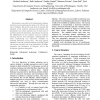Free Online Productivity Tools
i2Speak
i2Symbol
i2OCR
iTex2Img
iWeb2Print
iWeb2Shot
i2Type
iPdf2Split
iPdf2Merge
i2Bopomofo
i2Arabic
i2Style
i2Image
i2PDF
iLatex2Rtf
Sci2ools
CSCWD
2009
Springer
2009
Springer
Collaborative technologies in international distance education
We present a case study of an international distance education course involving two sites in the US and one site in Pakistan. We use the case study to examine the elements of the distance learning environment, and specifically how those elements can be best used to promote classroom interaction. In particular we discuss the effectiveness of two software tools for distance learning that we have developed: ConferenceXP for video conferencing and Classroom Presenter to facilitate interaction across sites. We bring special attention to the use of student artifacts including digital ink and text, and their use in the presentation of design proposals, the facilitation of critiques, and in the promotion of general interaction.
| Added | 26 May 2010 |
| Updated | 26 May 2010 |
| Type | Conference |
| Year | 2009 |
| Where | CSCWD |
| Authors | Richard J. Anderson, Ruth E. Anderson, Natalie Linnell, Mansoor Pervaiz, Umar Saif, Fred Videon |
Comments (0)

